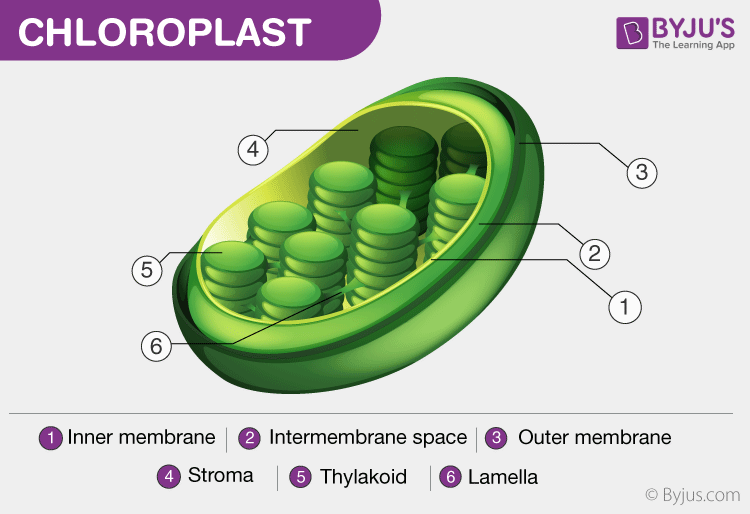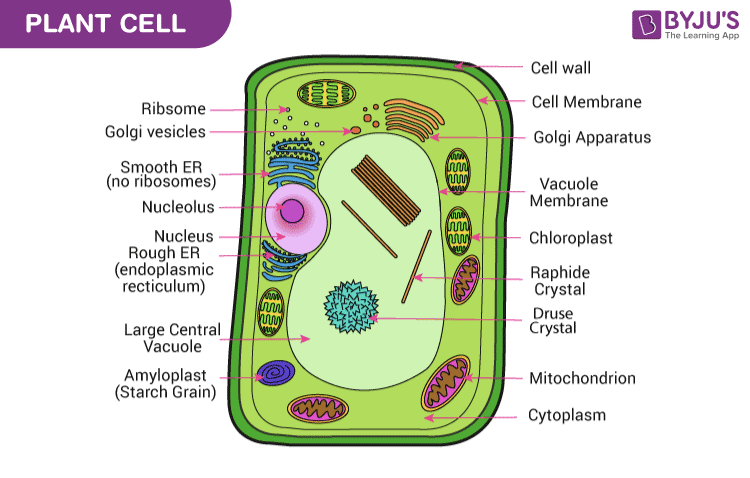The cell is the basic unit of life in all organisms. Like humans and animals, plants are also composed of several cells. The plant cell is surrounded by a cell wall which is involved in providing shape to the plant cell. Apart from the cell wall, there are other organelles that are associated with different cellular activities.


Let us have a detailed look at the plant cell, its structure, and the functions of different plant cell organelles.
Plant Cell Definition
“Plant cells are eukaryotic cells with a true nucleus along with specialized structures called organelles that carry out certain specific functions.”
Table of Contents
What is a Plant Cell?
Plant cells are eukaryotic cells that vary in several fundamental factors from other eukaryotic organisms. Both plant and animal cells contain a nucleus along with similar organelles. One of the distinctive aspects of a plant cell is the presence of a cell wall outside the cell membrane.
Read more: Cells
Plant Cell Diagram
The plant cell is rectangular and comparatively larger than the animal cell. Even though plant and animal cells are eukaryotic and share a few cell organelles, plant cells are quite distinct when compared to animal cells as they perform different functions. Some of these differences can be clearly understood when the cells are examined under an electron microscope.
Also Read: Cellulose in Digestion
Plant Cell Structure
Just like different organs within the body, plant cell structure includes various components known as cell organelles that perform different functions to sustain itself. These organelles include:
Cell Wall
It is a rigid layer which is composed of polysaccharides cellulose, pectin and hemicellulose. It is located outside the cell membrane. It also comprises glycoproteins and polymers such as lignin, cutin, or suberin.
The primary function of the cell wall is to protect and provide structural support to the cell. The plant cell wall is also involved in protecting the cell against mechanical stress and providing form and structure to the cell. It also filters the molecules passing in and out of it.
The formation of the cell wall is guided by microtubules. It consists of three layers, namely, primary, secondary and the middle lamella. The primary cell wall is formed by cellulose laid down by enzymes.
Also Read: Cell Wall
Cell membrane
It is the semi-permeable membrane that is present within the cell wall. It is composed of a thin layer of protein and fat.
The cell membrane plays an important role in regulating the entry and exit of specific substances within the cell.
For instance, cell membrane keeps toxins from entering inside, while nutrients and essential minerals are transported across.
Also Read: Cell Wall and Cell Membrane
Nucleus
The nucleus is a membrane-bound structure that is present only in eukaryotic cells. The vital function of a nucleus is to store DNA or hereditary information required for cell division, metabolism and growth.
- Nucleolus: It manufactures cells’ protein-producing structures and ribosomes.
- Nucleopore: Nuclear membrane is perforated with holes called nucleopore that allow proteins and nucleic acids to pass through.
Explore more: The Nucleus
Plastids
They are membrane-bound organelles that have their own DNA. They are necessary to store starch and to carry out the process of photosynthesis. It is also used in the synthesis of many molecules, which form the building blocks of the cell. Some of the vital types of plastids and their functions are stated below:
Leucoplasts
They are found in the non-photosynthetic tissue of plants. They are used for the storage of protein, lipid and starch.
Chloroplasts
It is an elongated organelle enclosed by phospholipid membrane. The chloroplast is shaped like a disc and the stroma is the fluid within the chloroplast that comprises a circular DNA. Each chloroplast contains a green coloured pigment called chlorophyll required for the process of photosynthesis. The chlorophyll absorbs light energy from the sun and uses it to transform carbon dioxide and water into glucose.
Also Read: Chloroplasts

Chromoplasts
They are heterogeneous, coloured plastid which is responsible for pigment synthesis and for storage in photosynthetic eukaryotic organisms. Chromoplasts have red, orange and yellow coloured pigments which provide colour to all ripe fruits and flowers.
Central Vacuole
It occupies around 30% of the cell’s volume in a mature plant cell. Tonoplast is a membrane that surrounds the central vacuole. The vital function of the central vacuole apart from storage is to sustain turgor pressure against the cell wall. The central vacuole consists of cell sap. It is a mixture of salts, enzymes and other substances.
Also read: Vacuoles
Golgi Apparatus
They are found in all eukaryotic cells, which are involved in distributing synthesised macromolecules to various parts of the cell.
Explore more: Golgi Apparatus
Ribosomes
They are the smallest membrane-bound organelles which comprise RNA and protein. They are the sites for protein synthesis, hence, also referred to as the protein factories of the cell.
Explore more: Ribosomes
Mitochondria
They are the double-membraned organelles found in the cytoplasm of all eukaryotic cells. They provide energy by breaking down carbohydrate and sugar molecules, hence they are also referred to as the “Powerhouse of the cell.”
Explore more: Mitochondria
Lysosome
Lysosomes are called suicidal bags as they hold digestive enzymes in an enclosed membrane. They perform the function of cellular waste disposal by digesting worn-out organelles, food particles and foreign bodies in the cell. In plants, the role of lysosomes is undertaken by the vacuoles.
Also read: Lysosomes
Plant Cell Types
Cells of a matured and higher plant become specialised to perform certain vital functions that are essential for their survival. Few plant cells are involved in the transportation of nutrients and water, while others for storing food.
The specialised plant cells include parenchyma cells, sclerenchyma cells, collenchyma cells, xylem cells and phloem cells.
Following are some of the different types of plant cells:
Collenchyma Cells
They are hard or rigid cells, which play a primary role in providing support to the plants when there is restraining growth in a plant due to lack of hardening agent in primary walls.
Sclerenchyma Cells
These cells are more rigid compared to collenchyma cells and this is because of the presence of a hardening agent. These cells are usually found in all plant roots and mainly involved in providing support to the plants.
Parenchyma Cells
Parenchyma cells play a significant role in all plants. They are the living cells of plants, which are involved in the production of leaves. They are also involved in the exchange of gases, production of food, storage of organic products and cell metabolism. These cells are typically more flexible than others because they are thinner.
Xylem Cells
Xylem cells are the transport cells in vascular plants. They help in the transport of water and minerals from the roots to the leaves and other parts of the plants.
Phloem Cells
Phloem cells are other transport cells in vascular plants. They transport food prepared by the leaves to different parts of the plants.
Refer more: Plant Tissue System
Plant Cell Functions
Plant cells are the building blocks of plants. Photosynthesis is the major function performed by plant cells.
Photosynthesis occurs in the chloroplasts of the plant cell. It is the process of preparing food by the plants, by utilising sunlight, carbon dioxide and water. Energy is produced in the form of ATP in the process.
A few plant cells help in the transport of water and nutrients from the roots and leaves to different parts of the plants.
To more about a plant cell, its definition, structure, diagram, types and functions, keep visiting BYJU’S Biology website or download BYJU’S app for further reference.


Nice information and thanks
for helping
super sir
I am making a model on this plant cell for my science class!!!
Iam very happy for your summarized information about plant cell in biology.
Thank you for the info 🤗
Best sir
Thanks for the help
Best sir
Useful information, thanx
thanks for a good function example becasue my schools text books do not have a function and i coul not find a good one eneywhere else
What are functions of plant and Animal cell
Plant Cell and animal cells have one primary function – to ensure the survival of the organism. Looking deeper, Plant cells and animal cells have tiny structures called cell organelles which perform various other functions to ensure the survival of the cell.
Nice
What part of the plant cell is responsible for providing it structure?
The cell wall is responsible for providing structural support in plants.
Thank you.
It was a very comprehensive detail. It helped me a lot to prepare my ppt for grade 6&7
Very Epic
Best 👍💯sir
Waah very nice 😀😎😇
Nice 🥰
it is a very good site for kids learning
Lovely! 😉
Very informative . This makes exams lot easier
really good
Thanks for good information
THANKS FOR THE INFORMATION
have the lysosomes perform same function in plant and animal cell
Lysosomes are exclusively found in animal cells. Plant cells have lytic vacuoles, which perform the same function as lysosomes in animal cells
Thanks for this helpful info.
good info
What a nice and fantastic blog, I read it thoroughly and learn a lot
Thank you so much for the great info I really needed this
Thanks for the info
Thanks sir
Thanks for this lovely info I easily understand this
nice good info
I was looking at this during a test and it was phenomenal.
Wow! I am working on a 5th-grade cell project and this was just the thing I needed!
5 stars!
great info
Thanks for this content
very nice information and explanation
This is really helpful thank you.
Thank you
Helped a lot to complete my bio project.
I scored full marks.
THANKS BYJU’S
Thanks for the detailed and elaborate information.
Thank you sir .🙏🙏🙏
Thank u for lots of information
Thank you for the lesson
Thank you for your support
Thanks❤
Best answer and clear visual explaining 👍🏻🤓💯
It is very useful
Thanks to you… I got everything that I needed…It was so Important for my Project…😊❤❤❤
I like the information
Difference between plant cell and animal cell.
You can find the Difference between plant and animal cell here.
Love this thank you so much 😊
It was very helpful
i want biology diagrams
Hello ,
I want prepare for my exams can you help me so that I can make good score in exams plz